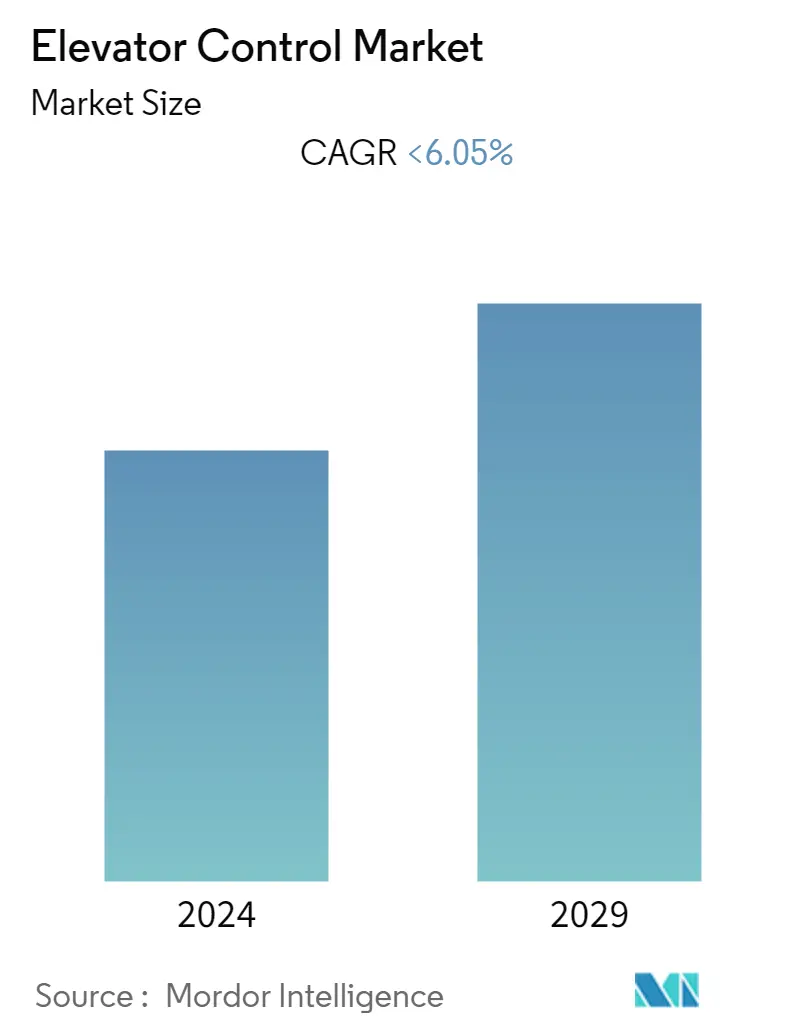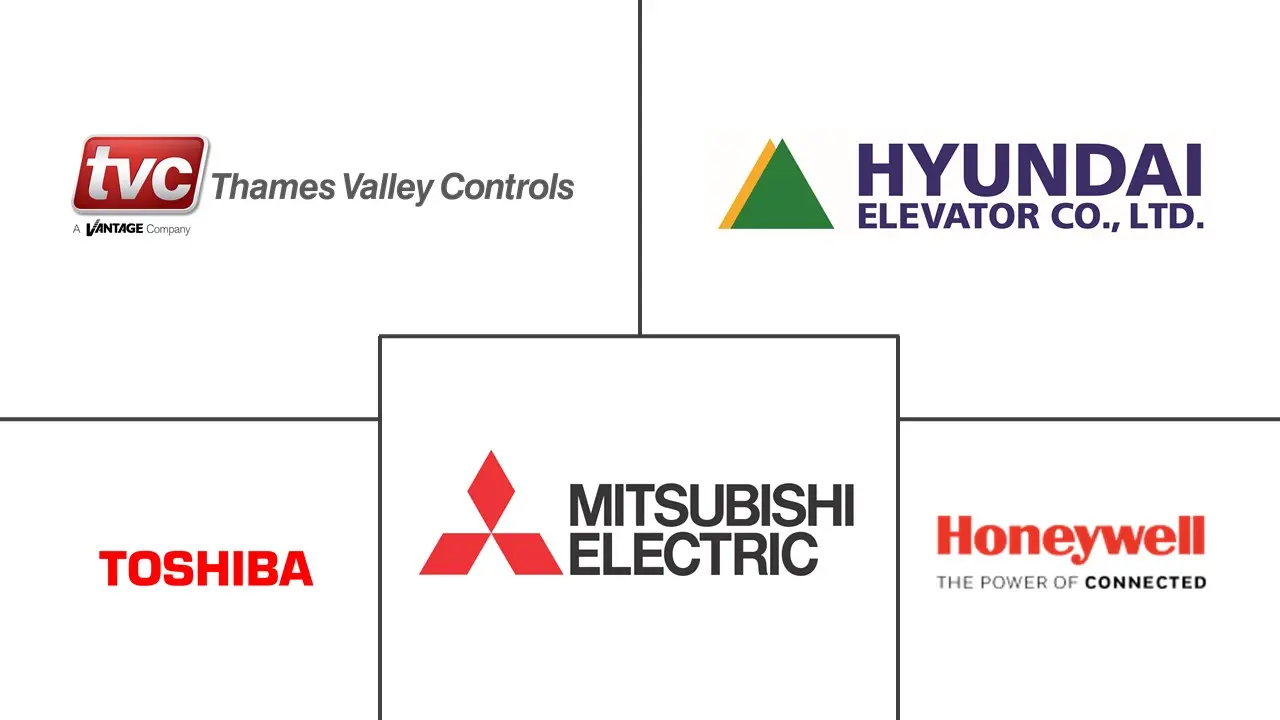Market Size of Elevator Control Industry

| Study Period | 2019 - 2029 |
| Base Year For Estimation | 2023 |
| CAGR | 6.05 % |
| Fastest Growing Market | Asia Pacific |
| Largest Market | North America |
| Market Concentration | Medium |
Major Players
*Disclaimer: Major Players sorted in no particular order |
Elevator Control Market Analysis
The global elevator control market (henceforth referred to as the market studied) was valued at USD 6.91 billion in 2020, and it is expected to reach USD 9.80 billion by 2026, registering a CAGR of around 6.05%, during the period of 2021-2026 (henceforth referred to as the forecast period). The outbreak of the COVID-19 across the globe has significantly disrupted the supply chain and production of the elevator control market in 2020. To prevent the spread of the coronavirus, governments in several nations have limited the number of personnel across variuos industry verticals.
- Rise in urbanization across the world in search of a job and better life standard has led to an increase in demand for residential apartments. In order to cater to the needs, governments have supported the construction of the multi-storey building to accommodate the maximum number of families in the same land area. According to the United Nation, more than one half of the world population lives in urban areas, and virtually all countries are experiencing urbanization. Developed countries' large population resides in urban areas, whereas developing countries in Africa and Asia, still dwell in rural areas but will urbanize faster than other regions over the coming decades. It will drive the elevator control market in the coming years.
- The rapid increase in infrastructure spending in developing economies is expected to boost the elevator market. According to the report, India's infrastructure investment would grow by 43% in the fiscal year 2020-2021 projected by the government which would strengthen the demand of elevators and steel. Infrastructure spending by central, state governments and the private sector is forecast to be around USD 254 billion in 2020-21 compared with estimated spending of USD 178 billion in 2019-20.
- In addition, developments in elevator technology that leverage digitalizationto improve flow and travel time in busy mid and high-rise buildings, primarily commercial buildings are encouraging engineers to develop next generation smart elevator control systems. Smart connected buildings, Internet of Things capabilities, and evolving standards of safety and quality are the new generations elements evolving the elevator market. Key vendors would benefit after implementing these elements. For instance, KONE's BACnet PR18-compliant controller is a native BACnet device, fully integrated system, that doesn't require any elevator controls integrator or translation and allows building operator to manage, operate, and maintain smart buildings in the best and efficient ways.
- In the wake of technological advancements, companies are striving towards introducing technologically advanced products such as touchless elevators that will prevent the further spread of corona virus. Developments such as these will open new prospects for the market in the near future.
Elevator Control Industry Segmentation
The scope of the current publication on Elevator market includes new as well as retrofit demand/consumption of Elevator control units. In other words, we have identified the demand for various types of hardware components and control systems integrated into the final installation, for both residential and commercial segments.
An elevator control unit is a system comprising of sensors, switches and controllers (primarily), to control the elevators both manually and automatically. The need for a control unit is aligned with performance of tasks such as coordination of elevator travel, door opening & closing speed, delays and leveling, to name a few.
Further, considering the competitive analysis, stakeholders such as elevator manufacturers (Mitsubishi, Toshiba etc.), standalone elevator control manufacturers (MEC, Thames Valley Controls) and component manufacturers (Honeywell, SICK) are made part of the analysis.
| Application | |
| Residential | |
| Commerical |
| Geography | |
| North America | |
| Europe | |
| Asia-Pacfic | |
| Rest of The World |
Elevator Control Market Size Summary
The elevator control market is poised for significant growth, driven by rapid urbanization and increased infrastructure investments globally. As more people migrate to urban areas in search of better job opportunities and living standards, the demand for residential and commercial high-rise buildings is on the rise. This trend is particularly evident in developing regions such as Asia and Africa, where urbanization is accelerating. Governments are supporting the construction of multi-storey buildings to accommodate growing populations, which in turn fuels the demand for advanced elevator control systems. The market is also benefiting from technological advancements, with innovations like smart elevator control systems and touchless elevators gaining traction. These developments are aimed at enhancing efficiency, safety, and convenience in building operations, aligning with the evolving standards of smart connected buildings and the Internet of Things.
The Asia-Pacific region is a key player in the elevator control market, with emerging economies like China, India, and Saudi Arabia making substantial investments in infrastructure projects. These investments are part of broader national strategies to boost urbanization and industrialization, creating new opportunities for the elevator control market. The region's rapid urbanization has led to the emergence of megacities, increasing the demand for modern infrastructure and towering skyscrapers. Major companies in the market, such as Mitsubishi Electric and Hyundai Elevator, are focusing on strategic partnerships and technological innovations to enhance their market presence. These companies are leveraging advanced technologies like voice recognition and facial recognition to improve elevator systems, aiming to capture a larger market share in the burgeoning Asia-Pacific region.
Elevator Control Market Size - Table of Contents
-
1. MARKET DYNAMICS
-
1.1 Market Overview
-
1.2 Porter's Five Force Analysis
-
1.2.1 Threat of New Entrants
-
1.2.2 Bargaining Power of Buyers/Consumers
-
1.2.3 Bargaining Power of Suppliers
-
1.2.4 Threat of Substitute Products
-
1.2.5 Intensity of Competitive Rivalry
-
-
1.3 Industry Value Chain Analysis
-
1.4 Assessment of COVID-19 Impact on the Industry
-
1.5 Market Drivers
-
1.5.1 Rapid Implementation of Advance Technologies in Control System
-
1.5.2 Increase Investment in Infrastructure
-
-
1.6 Market Challenges
-
1.6.1 High Initial Cost of Investment
-
-
-
2. MARKET SEGMENTATION
-
2.1 Application
-
2.1.1 Residential
-
2.1.2 Commerical
-
-
2.2 Geography
-
2.2.1 North America
-
2.2.2 Europe
-
2.2.3 Asia-Pacfic
-
2.2.4 Rest of The World
-
-
Elevator Control Market Size FAQs
What is the current Elevator Control Market size?
The Elevator Control Market is projected to register a CAGR of less than 6.05% during the forecast period (2024-2029)
Who are the key players in Elevator Control Market?
Hitachi Ltd., Hyundai Elevator Co., Ltd. , Toshiba Elevators and Building Systems, Mitsubishi Electric and Thames Valley Controls are the major companies operating in the Elevator Control Market.

